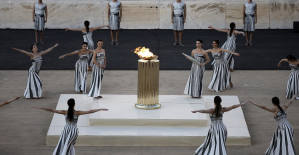Not only in Berlin, but in many cities, the New Year's Eve celebrations were overshadowed by riots. Herbert Reul (CDU), Interior Minister of North Rhine-Westphalia, sees a "new dimension" of aggressiveness in the attacks on emergency services on New Year's Eve. 250 alleged perpetrators were arrested on New Year's Eve in the largest federal state.
If you ask the interior ministries, fire brigade associations and police forces, there seems to be an accumulation of incidents in which the emergency services have been deliberately lured in order to attack them:
According to the police there, several young people set fire to garbage containers in Bonn and threw stones and pyrotechnics at the fire brigade during the subsequent firefighting operation. In Hagen, masked people built a street barricade, set it on fire - and then threw firecrackers and rockets at the incoming fire brigade. In Essen and Bochum, police officers were targeted when they tried to prevent groups from shooting rockets at each other. In Bottrop, police officers were thrown at with rockets and bottles.
According to the state fire brigade association, fire engines were ambushed in 14 cases in the federal capital Berlin, so that in some cases the firefighters had to flee. During extinguishing work, firecrackers and rockets were then fired at the emergency services, and there were attacks on at least 38 missions, with 15 employees injured.
According to the association, even abandoned emergency vehicles were looted by strangers in the capital. According to the latest information available to the police, 41 were injured, as a police spokesman said. A nationwide evaluation of New Year's Eve will only be completed in the coming days by the Federal Ministry of the Interior.
In Lower Saxony, according to the state association of the police union (DPolG), the most violent riots were in Hanover, in the nearby 60,000-inhabitant town of Garbsen and in Peine and Vechta. According to the State Criminal Police Office, there were also attacks on emergency services in Osnabrück and Delmenhorst. Numerous mobile phone videos, also available to WELT, show rocket fire on firefighters or bus stop windows being smashed.
Many of the videos are underlaid with songs by migrant rappers, and the short films contain text such as: "Fire brigade will never come back to Garbsen" (sic).
There have already been many media reports about the city, such as an RTL report on the "Auf der Horst" district, which is described as the "hardest focus", where reporters visited a kindergarten where 100 percent of the children have a migration background. According to the "Hannoversche Allgemeine Zeitung", the district was also the focus of the riots on New Year's Eve.
According to Lower Saxony's Minister of the Interior, Boris Pistorius (SPD), the attackers are "almost exclusively young men" who came "partly from right-wing extremists, but also from migrant backgrounds". That's why penalties are needed, which young men in particular are upset about - such as the withdrawal of their driver's license. Pistorius explained on NDR that the number of attacks in Lower Saxony this time was no higher than before the corona pandemic. However, "the intensity and the violence" would have increased.
After the riots on New Year's Eve, "the protection of the emergency services is needed, but also consistent criminal prosecution," says Berlin's Governing Mayor Franziska Giffey. She is now calling for nationwide consultations about a ban on firecrackers. An isolated solution would bring nothing.
Source: WORLD
According to the Interior Ministry there, things remained “relatively peaceful” in Hesse. However, the Hessian fire brigade association complains that firefighters in Offenbach-Dreieich were deliberately attacked with tear gas. Comrades rushing to help "were again victims of the tear gas attack".
In Frankfurt, too, "firefighters and police were shot at with pyrotechnics in a targeted manner" and barricades were erected. The violence against emergency services had "taken on a new dimension". Firecrackers were also thrown at vehicles – including emergency vehicles and police boats – and shops.
After the recent riots, Hamburg is considering extending the ban on fireworks, which already exists around the Binnenalster and on the Rathausmarkt. Firefighters and rescuers had been attacked in the Hanseatic city. In the Schnelsen district, a firefighter suffered burns when he and several colleagues were shot at with firecrackers.
In the more bourgeois district of Niendorf, an emergency doctor and a paramedic were attacked. In Hausbruch, a group of 50 volunteer fire brigades were fired at with firecrackers and rockets as they approached to unload a garbage container. In the same area, three buses from a group of 20 people were also attacked with pyrotechnics, police said.
Several police officers were also attacked in the Harburg and Hausbruch districts, as well as on the Reeperbahn, at the Landungsbrücken and on Schanzenstrasse. In St. Pauli, a 51-year-old officer was hit on the head and taken to the hospital with a laceration.
However, the police spokeswoman said: "We stand by the assessment that it was quieter than in previous years - even before Corona." In neighboring Schleswig-Holstein - in Elmshorn - a firefighter was threatened with a gun when he was extinguishing a garbage container . An 18-year-old was arrested during the subsequent manhunt.
In Baden-Württemberg, police and firefighters in Mannheim and Kehl were shot at with fireworks on New Year's Eve. Interior Minister Thomas Strobl (CDU) spoke of "typical New Year's Eve" operations and a "relatively normal" turn of the year.
Ralf Kusterer, state chairman of the German police union, cannot understand the minister's formulation: "If police and fire officers are injured, then you can never speak of a normal New Year's Eve, quite the opposite." The Ministry of the Interior in Stuttgart informed WELT, from "From the police point of view, it was a normal New Year's Eve in Baden-Württemberg". Nine slightly injured police officers in Aalen, Mannheim, Reutlingen and Stuttgart were reported to the Ministry of the Interior.
In Brandenburg there were fireworks attacks on police officers in Frankfurt (Oder). In Prenzlau, a 36-year-old fired several rockets in the direction of the police station and threw firecrackers at company cars. When two police officers then approached him, he hit the officers. In Potsdam, a group threw pyrotechnics and beer bottles at passing trams. Windows were broken.
According to the Saxon Ministry of the Interior, no officials were injured there on New Year's Eve, but emergency vehicles were occasionally damaged. According to the Minister of the Interior there, there were also no attacks on police officers or firefighters with pyrotechnics in neighboring Thuringia.
In the second largest state of Bavaria, the Ministry of the Interior has so far only been notified of cases from the Nuremberg metropolitan area, where four police officers were injured by firecrackers, but they were all still able to work.
"Kick-off Politics" is WELT's daily news podcast. The most important topic analyzed by WELT editors and the dates of the day. Subscribe to the podcast on Spotify, Apple Podcasts, Amazon Music, among others, or directly via RSS feed.

 War in Ukraine: when kyiv attacks Russia with inflatable balloons loaded with explosives
War in Ukraine: when kyiv attacks Russia with inflatable balloons loaded with explosives United States: divided on the question of presidential immunity, the Supreme Court offers respite to Trump
United States: divided on the question of presidential immunity, the Supreme Court offers respite to Trump Maurizio Molinari: “the Scurati affair, a European injury”
Maurizio Molinari: “the Scurati affair, a European injury” Hamas-Israel war: US begins construction of pier in Gaza
Hamas-Israel war: US begins construction of pier in Gaza First three cases of “native” cholera confirmed in Mayotte
First three cases of “native” cholera confirmed in Mayotte Meningitis: compulsory vaccination for babies will be extended in 2025
Meningitis: compulsory vaccination for babies will be extended in 2025 Spain is the country in the European Union with the most overqualified workers for their jobs
Spain is the country in the European Union with the most overqualified workers for their jobs Parvovirus alert, the “fifth disease” of children which has already caused the death of five babies in 2024
Parvovirus alert, the “fifth disease” of children which has already caused the death of five babies in 2024 Inflation rebounds in March in the United States, a few days before the Fed meeting
Inflation rebounds in March in the United States, a few days before the Fed meeting Video games: Blizzard cancels Blizzcon 2024, its annual high mass
Video games: Blizzard cancels Blizzcon 2024, its annual high mass Falling wings of the Moulin Rouge: who will pay for the repairs?
Falling wings of the Moulin Rouge: who will pay for the repairs? “You don’t sell a company like that”: Roland Lescure “annoyed” by the prospect of a sale of Biogaran
“You don’t sell a company like that”: Roland Lescure “annoyed” by the prospect of a sale of Biogaran Exhibition: in Deauville, Zao Wou-Ki, beauty in all things
Exhibition: in Deauville, Zao Wou-Ki, beauty in all things Dak’art, the most important biennial of African art, postponed due to lack of funding
Dak’art, the most important biennial of African art, postponed due to lack of funding In Deadpool and Wolverine, Ryan and Hugh Jackman explore the depths of the Marvel multiverse
In Deadpool and Wolverine, Ryan and Hugh Jackman explore the depths of the Marvel multiverse Tom Cruise returns to Paris for the filming of Mission Impossible 8
Tom Cruise returns to Paris for the filming of Mission Impossible 8 Skoda Kodiaq 2024: a 'beast' plug-in hybrid SUV
Skoda Kodiaq 2024: a 'beast' plug-in hybrid SUV Tesla launches a new Model Y with 600 km of autonomy at a "more accessible price"
Tesla launches a new Model Y with 600 km of autonomy at a "more accessible price" The 10 best-selling cars in March 2024 in Spain: sales fall due to Easter
The 10 best-selling cars in March 2024 in Spain: sales fall due to Easter A private jet company buys more than 100 flying cars
A private jet company buys more than 100 flying cars This is how housing prices have changed in Spain in the last decade
This is how housing prices have changed in Spain in the last decade The home mortgage firm drops 10% in January and interest soars to 3.46%
The home mortgage firm drops 10% in January and interest soars to 3.46% The jewel of the Rocío de Nagüeles urbanization: a dream villa in Marbella
The jewel of the Rocío de Nagüeles urbanization: a dream villa in Marbella Rental prices grow by 7.3% in February: where does it go up and where does it go down?
Rental prices grow by 7.3% in February: where does it go up and where does it go down? Even on a mission for NATO, the Charles-de-Gaulle remains under French control, Lecornu responds to Mélenchon
Even on a mission for NATO, the Charles-de-Gaulle remains under French control, Lecornu responds to Mélenchon “Deadly Europe”, “economic decline”, immigration… What to remember from Emmanuel Macron’s speech at the Sorbonne
“Deadly Europe”, “economic decline”, immigration… What to remember from Emmanuel Macron’s speech at the Sorbonne Sale of Biogaran: The Republicans write to Emmanuel Macron
Sale of Biogaran: The Republicans write to Emmanuel Macron Europeans: “All those who claim that we don’t need Europe are liars”, criticizes Bayrou
Europeans: “All those who claim that we don’t need Europe are liars”, criticizes Bayrou These French cities that will boycott the World Cup in Qatar
These French cities that will boycott the World Cup in Qatar Basketball: Strasbourg appeals the victory recovered by Monaco
Basketball: Strasbourg appeals the victory recovered by Monaco Top 14: UBB with Tatafu and Moefana against Bayonne
Top 14: UBB with Tatafu and Moefana against Bayonne MotoGP: Bagnaia dominates qualifying practice in Spain and sets track record
MotoGP: Bagnaia dominates qualifying practice in Spain and sets track record Olympic Games: in Athens, Greece transmits the Olympic flame to France
Olympic Games: in Athens, Greece transmits the Olympic flame to France


















